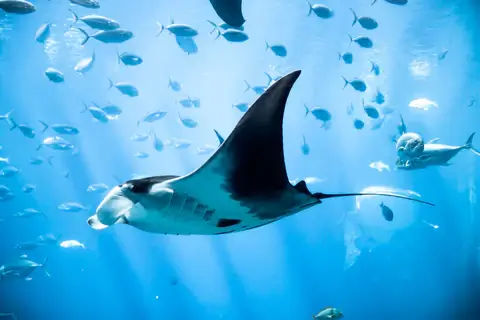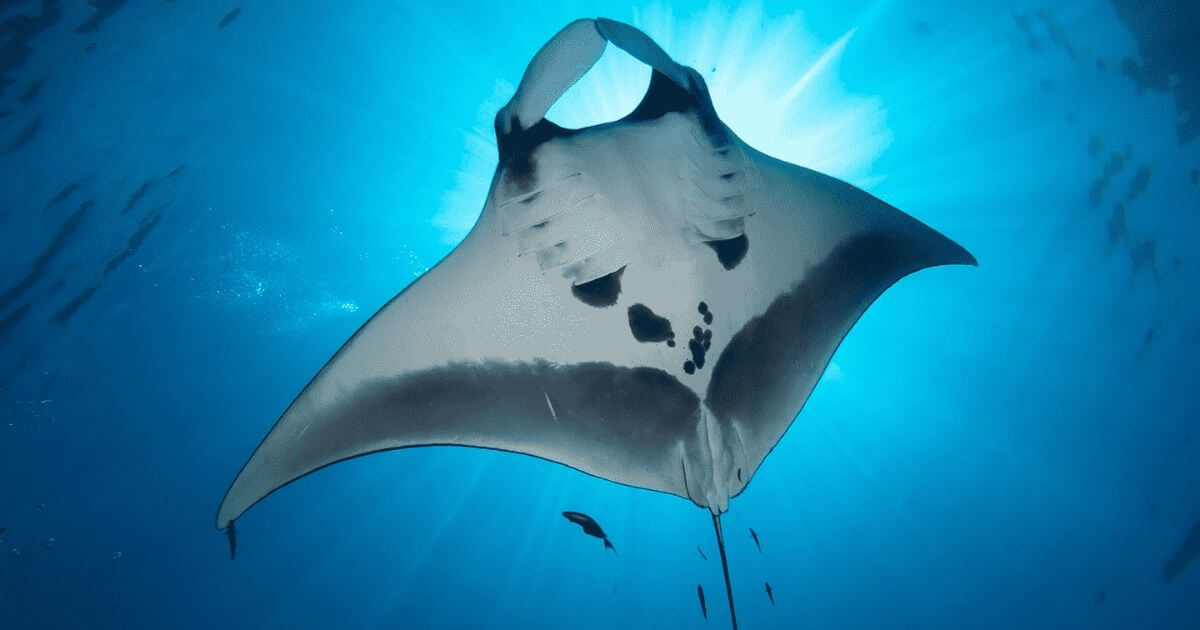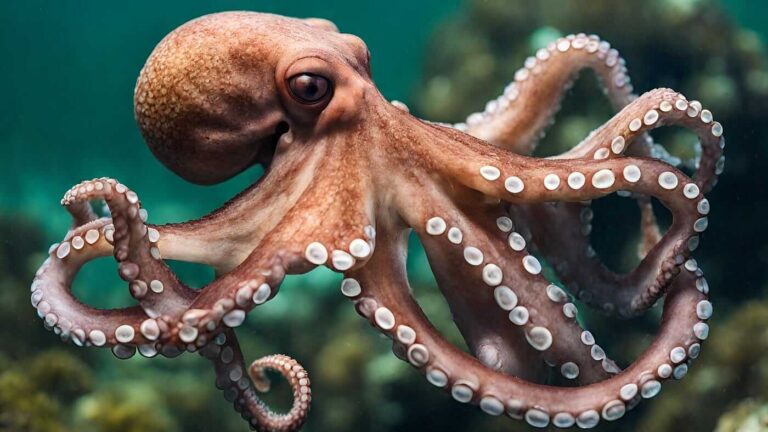Manta Ray: Facts, Habitat, Behavior, and Conservation Status
Manta rays are one of the ocean’s most graceful creatures, gliding through the water with their massive wingspan. Known for their gentle nature and impressive size, these majestic rays capture the fascination of marine enthusiasts worldwide. This article will explore the scientific classification, physical characteristics, habitat, behavior, diet, reproduction, predators, conservation status, and other intriguing aspects of the manta ray, including its relationship with humans.
Contents
Scientific Classification
Manta rays belong to the family Mobulidae and are divided into two main species:
- Manta birostris (the giant oceanic manta ray)
- Manta alfredi (the reef manta ray)
- Kingdom: Animalia
- Phylum: Chordata
- Class: Chondrichthyes (cartilaginous fish)
- Order: Myliobatiformes
- Family: Mobulidae
- Genus: Manta
- Species: M. birostris, M. alfredi
Physical Characteristics

Manta rays are easily recognized by their flat, diamond-shaped bodies and broad pectoral fins resembling wings. Some key characteristics include:
- Size: The giant manta ray can have a wingspan of up to 7 meters (23 feet) and weigh over 1,350 kg (3,000 lbs). The reef manta is smaller, with a wingspan of up to 5.5 meters (18 feet).
- Colouration: Mantas have a dark back with white or light-coloured undersides. Some have unique spot patterns on their bellies, which researchers use for individual identification.
- Cephalic Fins: Mantas have two “cephalic fins” on either side of their mouth, which they channel plankton into their mouths as they feed.
- Gills: Located on the underside, the gills of manta rays are essential for filter feeding.
Habitat and Distribution
Manta rays are found in tropical, subtropical, and temperate waters worldwide. Their habitat preferences differ between the two species:
- Manta birostris: Prefers open oceans, often venturing into deeper waters.
- Manta alfredi: Typically found near coral reefs, islands, and coastal areas.
They are known to migrate vast distances, traveling to specific locations for feeding, cleaning, and mating.
Behavior
Manta rays are solitary creatures but can also be found in groups, especially during feeding or cleaning sessions. Known for their intelligence, they demonstrate complex social behaviors, such as visiting “cleaning stations” where smaller fish, like wrasses, remove parasites from their bodies.
Mantas are gentle swimmers, and despite their size, they move gracefully through the water by flapping their pectoral fins and gliding. They are also known to breach the water, leaping into the air, although the exact reason for this behavior is not well understood.
Diet and Feeding
Manta rays are filter feeders, primarily consuming plankton, small fish, and microscopic marine organisms. They swim with their mouths open, using their cephalic fins to guide food into their mouths and through their specialized gill rakers, which filter the plankton from the water.
They feed in a variety of ways:
- Surface Feeding: Skimming the surface of the water.
- Barrel Rolls: A spiral motion performed while feeding in dense plankton patches.
- Group Feeding: Occurs when multiple manta rays come together in a large feeding aggregation.
Reproduction
Manta rays have one of the slowest reproductive rates among fish. They are ovoviviparous, meaning the eggs develop inside the mother, and she gives birth to live young.
- Gestation Period: Around 12-13 months.
- Birth: Mantas typically give birth to a single pup, though twins are rare.
- Maturity: Manta rays reach sexual maturity at around 8-10, and females give birth every 2-5 years.
Manta rays have long lifespans, with some living up to 50 years or more in the wild.
Predators and Threats
Due to their large size, manta rays have few natural predators. Large sharks, such as tiger and bull sharks, and killer whales are known to prey on manta rays, particularly juveniles.
However, the biggest threat to manta rays comes from humans:
- Bycatch: Mantas often become entangled in fishing gear.
- Fishing: Targeted fishing for their gill plates, used in traditional Chinese medicine.
- Pollution: Plastic debris and pollutants in the ocean harm mantas, either through ingestion or habitat destruction.
Conservation Status
Both species of manta rays are listed as Vulnerable on the International Union for Conservation of Nature (IUCN) Red List. Their slow reproductive rates, overfishing, and habitat destruction have led to declining populations.
Several conservation efforts are underway to protect manta rays:
- Marine Protected Areas (MPAs): Designated regions where manta rays are protected from fishing and human interference.
- CITES: Both manta species are listed under Appendix II of the Convention on International Trade in Endangered Species (CITES), regulating their trade.
Exciting Facts About Manta Rays
- Brain Size: Manta rays have the most significant brain-to-body ratio of any fish species, indicating high intelligence and complex behavior.
- Breaching: Manta rays can leap out of the water, sometimes reaching several feet. Scientists believe this behavior may be related to communication, courtship, or parasite removal.
- Cleaning Stations: Manta rays regularly visit “cleaning stations” on reefs where cleaner fish, such as wrasses, pick parasites from their skin, gills, and mouths.
- Unique Spot Patterns: Each manta ray has a unique spot pattern on its underside, which researchers use to identify individuals.
Evolutionary History
Manta rays evolved from bottom-dwelling stingrays. Unlike their ancestors, mantas adapted to a pelagic lifestyle, swimming in open waters. Over millions of years, they evolved to lose their sting, as they no longer needed it for defence. Their large size and fast swimming abilities helped them evade predators, and their filter-feeding mechanism allowed them to thrive on abundant plankton.
Manta rays are closely related to other rays and skates, and their closest relatives include smaller species like the cownose ray.
Manta Rays and Humans
Manta rays have a mostly positive relationship with humans. Due to their gentle nature, they are popular attractions for divers and snorkelers in many tropical locations. Their graceful swimming and curious behavior often make encounters with humans a memorable experience.
However, the rise in tourism can sometimes negatively impact manta rays if not appropriately managed. Boat traffic, pollution, and habitat degradation can harm these gentle giants. On the other hand, manta tourism has also led to increased awareness and conservation efforts to protect their populations.
Conclusion
Manta rays are remarkable creatures that play a crucial role in marine ecosystems. From impressive size to unique feeding habits and intelligence, they are one of the ocean’s most fascinating inhabitants. However, they face numerous threats from human activity, making conservation efforts vital for their survival. As we continue to learn more about these gentle giants, we must protect their habitats and ensure their populations thrive for future generations.
- Golden Retriever Pros and Cons: What Every Pet Parent Should Know - 15 September 2025
- Cane Corso Dog Breed: Health, Care, and Lifespan - 14 September 2025
- Catahoula Leopard Dogs: Description, Temperament, Lifespan, & Facts - 21 July 2025







